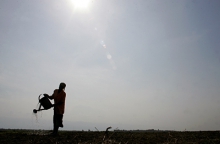Water is key to food security
Saturday, 09.03.2011, 11:36am (GMT3)
Everybody understands that water is crucial for growing food - but often in an abstract way. Can you give more details on how water helps feed the world?

First of all, it's important to make the distinction between rainfed agriculture - farming that depends on natural rainfall - and irrigated agriculture. Irrigating land changes everything - it concentrates inputs and forces changes in agronomy and marketing.
While many people in the Horn of Africa are pastoralists, not crop farmers, the current situation there makes it painfully clear the risks and vulnerability associated with rainfed food production systems, especially as the impacts of a changing climate are now making themselves felt. It's not that rainfed agriculture is a problem per se, but it is more vulnerable, and tends to be less productive.
As regards irrigation, one can't understate the contribution it has made to feeding the world. Over the last 50 years, the Earth's population doubled and the global food system responded remarkably to the increase in food demand. This was done through just a modest increase in total cropland -- not more than 12 percent. The achievement occurred mainly through intensification of agricultural production, i.e. an increase in yield and cropping intensity, which in turn would not have been possible without irrigation.
Irrigated land has increased proportionally much faster than land under rainfed agriculture. In fact, while the world's cultivated area has grown only by 12% over the last fifty years, irrigated area has doubled over the same period, accounting for most of the net increase in cultivated land. Meanwhile, agricultural production has grown between 2.5 and 3 times, thanks to significant increase in the yield of major crops.
Hasn't the world's capacity to irrigate farmland been reached?
In some places, yes, in others, no.
Globally, some 300 million hectares of farmland is irrigated, accounting for 70% of all freshwater appropriations. That is happening on only 20% of the world's cultivated land -- yet at the same time, that irrigated land accounts for 40% of all agricultural production and 60% of cereal production.
Why isn't more farmland irrigated? In some places it may not be necessary. In others, water resources may not be available. Elsewhere, financing for irrigation and market linkage is the problem - and here I'm thinking of Africa in particular. We have not seen the wholesale commitment to modernize irrigated production and marketing into changing local and global markets - even when land and water resources have been available
But aren't other world regions running out of water?
Increasing regions of the world are indeed facing water scarcity and face the risk of progressive breakdown of their productive capacity under a combination of demographic pressure and unsustainable agricultural practices. The physical limits to land and water availability within these systems may be further exacerbated in places by external factors, including climate change, competition with other sectors and socio-economic changes.
Toward 2050, rising population and incomes are expected to require 70 percent more food production globally, and up to 100% more in developing countries. But some regions are coming very close to their potential to intensify food production, which is already leading to tension on access to natural resources, in particular water. East Asia and The Middle East are operating very close to their limits and will not be able to extend their agriculture much further, while substantial potential is still available in Latin America and in sub-Saharan Africa.
So what can be done?
Despite the challenges, the prospect does exists for further increases in productivity, both in rainfed and irrigated agriculture, but we'll need to make changes in how we farm and use water.
Irrigation, where possible, will continue to grow in respond to demand for more and more diversified production. While in some regions there is no scope for further increase in water supply for agriculture, in others there will still be opportunities. Most large scale water storages have probably been constructed already, and it is likely that more diffuse and distributed systems of water storage will continue to be developed. The combined use of groundwater and surface water will also become more widespread, and, near cities, agriculture will likely take more systematic advantage of treated waste water.
A lot needs to happen in terms of how we irrigate, as well. Old, rigid systems of water distribution in large irrigation schemes will need to be replaced by much more flexible systems, allowing for more reliability in the supply of water and therefore progressive diversification towards higher value crops. In such modernized systems, localized irrigation will play an important role in boosting productivity while reducing non beneficial uses of water, therefore increasing on-farm water use efficiency and productivity.
We'll also need to focus on getting "more crop per drop," by adopting farming techniques that harvest more rainfall, conserve soil moisture, reduce waste in irrigation and in some cases by making changes in dietary and cropping choices to focus on crops and foods that use less water.
Finally, much more needs to be done to reduce wastages between farm gates and the consumer. It is estimated that only about 50% of the food that is produced is actually consumed, the rest being lost in storage, distribution and at the level of end users.
That's not just food waste -- it's water waste too if production is irrigated. The production of 1 calorie of food requires 1 liter of water. With the world's average daily caloric requirement at about 2800 per person, the water needed to satisfy the daily food requirements of each individual on the planet is about 2 800 liters. Or to put it another way, to produce one hamburger it takes 2 400 liters of water. A glass of milk? 200 liters. One egg - 135 liters. A slice of bread takes 40 liters. So reducing food waste is key to improving the efficiency of agriculture's use of water.
23 August 2011 http://www.fao.org/news/story/en/item/86991/icode/
|
